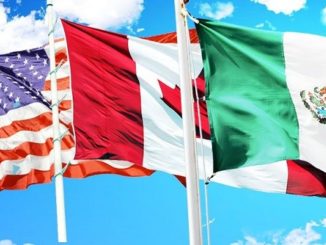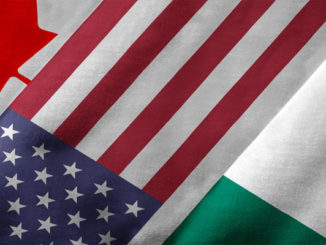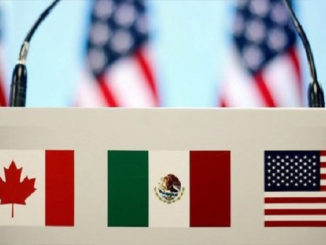by Ernesto Zedillo
Representatives from the United States, Mexico and Canada are meeting in Washington Monday for continued negotiations over the North American Free Trade Agreement. A year ago, when Robert Lighthizer, the U.S. trade representative, notified Congress that the Trump administration aimed to renegotiate NAFTA, the intent seemed legitimate and benign. But it is clear by now that this is not the case.
At the time, Lighthizer argued that the 25-year-old agreement did not reflect the standards warranted by changes in the economy. Provisions on digital trade, for instance, could not have been adequately incorporated into NAFTA in the early 1990s. Understandably, Lighthizer argued that supporting better-paid jobs and faster U.S. economic growth should be the objective of the modernized NAFTA. It was also alleged that the agreement needed to be updated on key issues such as intellectual property rights and labor and environmental provisions.
Had these laudable objectives been the sincere intent of renegotiating the agreement, no one would have raised an eyebrow. And most likely, the deal would have been happily concluded by now. From day one, however, there were grounds to doubt the truthfulness of the administration’s position.
For starters, practically every topic included on the to-do list had already been addressed in the Trans-Pacific Partnership (TPP) that was discarded by the Trump administration. Both Mexico and Canada were parties to the TPP. If NAFTA had been modernized in practice through the TPP, why call for the renegotiation of the former while trashing the latter?
Unfortunately, it did not take long to confirm skeptics’ worst fears about the U.S. government’s intent for a new NAFTA. In mid-July, Lighthizer published more detailed objectives for the renegotiation that included wrongheaded arguments. For example, the American negotiators falsely associated NAFTA with the explosion of U.S. trade deficits, the closure of thousands of factories and the abandonment of millions of American workers — as if the steady advance of automation and the 2008 financial crisis didn’t happen. Let’s be clear: NAFTA caused none of that.
On the contrary, analyses have shown that the agreement helped to make American companies more competitive in the global market and supported the creation of millions of jobs in the United States, while benefitting American consumers. Some 14 million jobs today rely on trade with Canada and Mexico, while the nearly 200,000 export-related jobs created annually by the pact pay 15 to 20 percent more on average than the jobs that were lost. And the integration of supply chains has made it clear that NAFTA saved the U.S. auto industry from possibly collapsing and taking all those manufacturing jobs with it.
The objective of getting a new NAFTA that improves the U.S. trade balance and reduces the trade deficit with Mexico and Canada is also utterly misplaced. Countries have trade deficits in their balance of payments when they spend more than they produce. There is little, if anything, that trade policy can do to fix this type of imbalance. Shrinking the fiscal deficit is usually what is most effective to fix trade deficits. It is also absurd to focus on bilateral or sectorial deficits rather than total trade deficits.
Given the fallacious nature of some of the arguments and objectives used by the U.S. government to pursue a new NAFTA, it should not come as a surprise how awkward and unpalatable a number of its specific demands at the negotiating table have proven to be.
Take the demand about a sunset clause, by which the agreement would be up for termination every five years unless the three governments agree otherwise. Or consider the one about eliminating the NAFTA provisions that discourage the abuse of the so-called unfair trade laws by which trade partners can capriciously impose measures like antidumping duties. These and other American proposals would undermine the predictability that international agreements are first and foremost supposed to provide.
Under NAFTA, those within the region export to each other at preferential rates as long as goods involved comply with the rules of origin requirement — that is, a certain percentage of the value of the exported good must come from the region itself. But the U.S. insists on modifying these rules, largely with the U.S. automotive industry in mind. Not only do U.S. negotiators want to significantly increase the required level of regional content, they also, inequitably, want to impose a required level of U.S. content higher than that of its NAFTA partners. More recently, Lighthizer proposed a particularly discriminatory regime in which tariffs would be higher for Mexico because its wages are lower.
Thus, bewilderingly, U.S. negotiators are pushing for a highly convoluted and discriminatory system while ignoring, or perhaps knowing, that such a system would not only be bad for Mexico and Canada but also for American consumers and producers in the U.S. automotive industry. American car makers would lose competitiveness and shares in world markets, possibly even in their domestic market, to their European and Asian competitors.
Oddly, U.S. representatives are also asking for changes to make it easier for them to impose seasonal anti-dumping tariffs on a number of fruits and vegetables, in order to make imports of these products more expensive at the convenience of some domestic producers, irrespective of the adverse consequences for domestic consumers. Furthermore, the United States wants its NAFTA partners to open government procurement purchases to U.S. firms but insists on doing the opposite for Canadian and Mexican firms in the United States.
To make matters worse, U.S. negotiators have further demanded to make the NAFTA investor-state dispute settlement system optional, so that the United States can withdraw from it if it so chooses. That would deny such protection to its own companies, thus discouraging them from investing in Mexico and Canada.
From these and other grotesque demands, it’s clear that what the U.S. government seeks is not to modernize the old NAFTA but rather to get an agreement that would destroy trade and investment among the three North American partners. It perversely aims to get Mexico and Canada’s seal of approval to carry out the demolition of the most successful undertaking ever of mutually beneficial economic cooperation in the Americas.
The Canadian and Mexican governments are to be praised for their serious efforts so far to preserve the openness of trade and investment provided by NAFTA. But under no circumstance should they sign on to an agreement that would do just the opposite.
The international trading system is under serious attack — paradoxically from its principal builder and beneficiary, the United States. Mexico and Canada are acting responsibly to protect that system at one of its first lines of defense, NAFTA itself.
But unless the U.S. government seriously reconsiders its proposed self-damaging trade policy, its two partners should move forward to protect and lean on another line of defense — the World Trade Organization multilateral system — and leave the U.S. government to assume alone full responsibility for killing NAFTA.
Ernesto Zedillo, a professor in the field of international economics and politics at Yale University, was president of Mexico from 1994 to 2000. He is also a member of the Berggruen Institute’s 21st Century Council.



